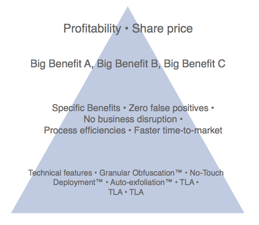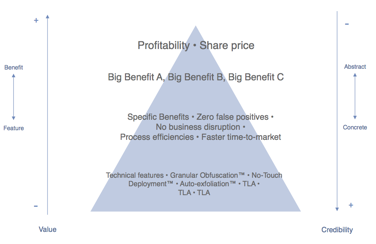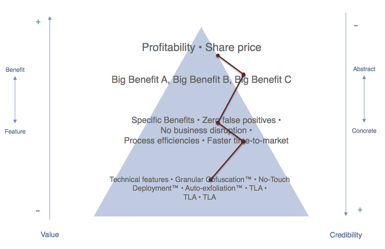Getting the hierarchy right: how to connect your technology features to your high-order order benefits and vice versa.
 Corporate Positioning and Corporate Message Development Paper in pdf Format
Corporate Positioning and Corporate Message Development Paper in pdf Format
When companies bring Velocity in to ‘sort out their messages’, we always ask what’s wrong with the way they’re currently telling their story. A surprising number say something like, “We’re okay talking about our technology and not so bad talking about the topline benefits, but there seems to be a gap somewhere in between.”
Even if they don’t say that, they ought to – because almost every technology company seems to get stuck trying to find the right balance between tech-talk, feature-speak and business benefits.
If all you do is talk big benefits, there’s no credibility. If you spend all your time on features, it’s a big, “So what?’.
To explore the issue, we like to present the Velocity Hierarchy of Benefits, which starts out looking something like this (with the client’s real features and benefits inserted)…
The Velocity Hierarchy of Benefits (How to Scope Your Corporate Positioning & Corporate Message Development Work in One Big, Easy Triangle)

As you can see, the technical features are at the bottom — they may be important but they’re not benefits in themselves.
The next layer up holds what a lot of techies might think of as benefits. Things like ‘process efficiencies’ or ‘best detection rates in the industry’. To people steeped in the market, just saying these things feels like benefit talk – but to others, they’re means rather than ends.
Next step up the pyramid are three Big Benefits – the core of the company’s positioning and the heart of its messages. ‘Drives down the cost of bunion removal’; ‘Eliminates the need for expensive audits’; ‘Lets you do three times more with the same people’.
These Big Benefits should be aired a lot. And sometimes, they’re as high as the company should ever go. Because the very highest level is either beyond the target audience’s domain or because it’s heavily suggested by the layer below.
At the very top of the Hierarchy are the real reasons companies do things: to increase profit, drive up the share price or both. Again, this level may be too high to use overtly in marketing, but it’s good to remember what the end-end benefit is, to keep everything else in perspective.
Now comes the interesting part.
We like to add two scales down the right and left sides of the Hierarchy, so it looks like this…
Value vs Credibility (Why Corporate Positioning & Corporate Message Development Work Ain’t So Easy!)

On the left hand side, we have “Value”, showing that the highest value things appear higher on the pyramid and the lowest value at the bottom.
On the right hand side, we have “Credibility” – but this time the arrow is reversed. The highest-value benefits are also the least credible and the most credible things are, unfortunately, the ones your prospects care least about.
The inversion of these two scales and their attributes – Value vs Credibility – strikes at the heart of the communications problem that the hierarchy represents.
The things people care about, they don’t believe. The things they’re happy to take on trust… don’t matter anyway.
Making Vines (How to Make Your Corporate Positioning & Corporate Message Development Work Stick!)
When people first see their Hierarchy of Benefits, there’s a lot of talk about ‘where we should be aiming’. It’s as if the challenge were to find the right level and put all marketing efforts there.
But that’s not the point. The point is to connect the lowest and highest levels in meaningful ways.
To create vertical chains, ‘Vines’ if you like, that link each feature to the benefit levels above; and each benefit to the lower-order benefits and features below. Kind of like this…

These Vines do two very important things:
They bring value to your features.
They give credibility to your benefit claims.
So instead of saying ‘We’re the only widget with Auto-exfoliation™” (who cares?), you find yourself saying, “Our Auto-Exfoliation™ technology means excess bytes are removed on-the-fly – saving administrators time and dramatically reducing the cost of sale.”
And instead of saying, “Our Widget makes you more profitable!” (says who?), you add credibility with something like, “Our Widget uses patented auto-exfoliation to remove the tasks that take 60% of every administrator’s day – and slow time-to-market by weeks. The result is more productive IT people and products that generate revenue instead of costs.”
Where you need Vines
You need Vines wherever you communicate sales messages to the market. On every web page, in every blog post, white paper, product demo, sales deck, webinar and video.
If you spot a tiny tech feature floating out on its own – link it up to a benefit. And if you find yourself making big bold benefit claims without support, link them up to credibility-builders from lower down the hierarchy.
Over-simplifying? No doubt. But keeping yourself aware of the inverse relationship between value and credibility is a powerful guide for finding the right balance in your own messaging and positioning work.

Enjoyed this article?
Take part in the discussion







Comments
Graham Lawlor November 25th, 2008
Hey Doug,
Just read your post and it makes a lot of sense. One thing I hear regularly from investors is that companies that are too tech focused (composed entirely of engineers) have difficulty explaining their value to potential customers. Sometimes it’s even that they get so immersed in the technology that they don’t really add much top-line value. On the other hand, I’ve seen companies so marketing-focused that the investor or client they’re pitching too never understands exactly what they’re doing or how. I like the way you explain the problem with the axes of Credibility and Value. Very nice.
Graham.
Erin November 25th, 2008
Great post! I think this is an issue a lot of companies struggle with. Especially when you really do provide a great benefit, you want your customers/users to trust the credibility of it. At the same time, you don’t want to inundate them with tech-speak they may not understand or care about. Even worse, you could totally scare them away.
It’s a fine line, but it looks like you guys have found a pretty decent map for walking it.
Chris Hall January 14th, 2009
Doug,
Great post. b2b programs and comms are critical for growth and should not be squeezed by 2.0 tactics. I just wrote a short piece on whether social media has relinquished the asylum to the patients:
http://www.chrishallmarketing.com/cgi-bin/dada/mail.cgi?flavor=archive&id=20090108144317&list=chm
Ben Hayes May 11th, 2009
Useful way to think about it. I like the vine idea, especially on the homepage/main landing pages.
John25 October 22nd, 2009
The novelty in our framework is that it establishes a particular hierarchy in goods space that is both amenable to empirical measurement and has determinate growth implications. ,
Chris Keller November 11th, 2010
In academic circles, linking products to customers is called hierarchical values map (HVM). It begins with product features at the bottom. Those features are linked to a second level product benefit. The third level is a personal benefit, and the fourth benefit is a personal value.
Good marketers should target their messaging at personal benefits.
It is nice to read this in your terms. Well done.
Doug Kessler November 12th, 2010
Thanks for the HVM insight. Sounds good. I’ll look it up.